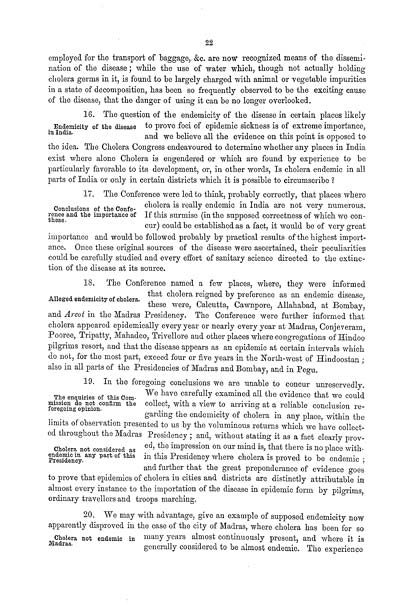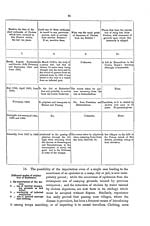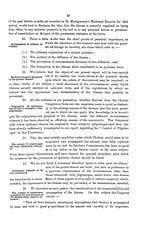Medicine - Disease > Report of cholera committee
(29) Page 22
Download files
Individual page:
Thumbnail gallery: Grid view | List view

22
employed for the transport of baggage, &c. are now recognized means of the dissemination
of the disease; while the use of water which, though not actually holding
cholera germs in it, is found to be largely charged with animal or vegetable impurities
in a state of decomposition, has been so frequently observed to be the exciting cause
of the disease, that the danger of using it can be no longer overlooked.
Endemicity of the disease
in India.
16. The question of the endemicity of the disease in certain places likely
to prove foci of epidemic sickness is of extreme importance,
and we believe all the evidence on this point is opposed to
the idea. The Cholera Congress endeavoured to determine whether any places in India
exist where alone Cholera is engendered or which are found by experience to be
particularly favorable to its development, or, in other words, Is cholera endemic in all
parts of India or only in certain districts which it is possible to circumscribe ?
Conclusions of the Conference and the importance of these.
17. The Conference were led to think, probably correctly, that places where
cholera is really endemic in India are not very numerous.
If this surmise (in the supposed correctness of which we con-
cur) could be established as a fact, it would be of very great
importance and would be followed probably by practical results of the highest importance.
Once these original sources of the disease were ascertained, their peculiarities
could be carefully studied and every effort of sanitary science directed to the extinction
of the disease at its source.
Alleged endemicity of cholera.
18. The Conference named a few places, where, they were informed
that cholera reigned by preference as an endemic disease,
these were, Calcutta, Cawnpore, Allahabad, at Bombay,
and Arcot in the Madras Presidency. The Conference were further informed that
cholera appeared epidemically every year or nearly every year at Madras, Conjeveram,
Pooree, Tripatty, Mahadeo, Trivellore and other places where congregations of Hindoo
pilgrims resort, and that the disease appears as an epidemic at certain intervals which
do not, for the most part, exceed four or five years in the North-west of Hindoostan;
also in all parts of the Presidencies of Madras and Bombay, and in Pegu.
The enquiries of this Commission do not confirm the
foregoing opinion.
Cholera not considered as
endemic in any part of this
Presidency.
19. In the foregoing conclusions we are unable to concur unreservedly.
We have carefully examined all the evidence that we could
collect, with a view to arriving at a reliable conclusion regarding
the endemicity of cholera in any place, within the
limits of observation presented to us by the voluminous returns which we have collected throughout the Madras Presidency ; and, without stating it as a fact clearly proved, the impression on our mind is, that there is no place within
this Presidency where cholera is proved to be endemic;
and further that the great preponderance of evidence goes
to prove that epidemics of cholera in cities and districts are distinctly attributable in
almost every instance to the importation of the disease in epidemic form by pilgrims,
ordinary travellers and troops marching.
Cholera not endemic in
Madras.
20. We may with advantage, give an example of supposed endemicity now
apparently disproved in the case of the city of Madras, where cholera has been for so
many years almost continuously present, and where it is
generally considered to be almost endemic. The experience
employed for the transport of baggage, &c. are now recognized means of the dissemination
of the disease; while the use of water which, though not actually holding
cholera germs in it, is found to be largely charged with animal or vegetable impurities
in a state of decomposition, has been so frequently observed to be the exciting cause
of the disease, that the danger of using it can be no longer overlooked.
Endemicity of the disease
in India.
16. The question of the endemicity of the disease in certain places likely
to prove foci of epidemic sickness is of extreme importance,
and we believe all the evidence on this point is opposed to
the idea. The Cholera Congress endeavoured to determine whether any places in India
exist where alone Cholera is engendered or which are found by experience to be
particularly favorable to its development, or, in other words, Is cholera endemic in all
parts of India or only in certain districts which it is possible to circumscribe ?
Conclusions of the Conference and the importance of these.
17. The Conference were led to think, probably correctly, that places where
cholera is really endemic in India are not very numerous.
If this surmise (in the supposed correctness of which we con-
cur) could be established as a fact, it would be of very great
importance and would be followed probably by practical results of the highest importance.
Once these original sources of the disease were ascertained, their peculiarities
could be carefully studied and every effort of sanitary science directed to the extinction
of the disease at its source.
Alleged endemicity of cholera.
18. The Conference named a few places, where, they were informed
that cholera reigned by preference as an endemic disease,
these were, Calcutta, Cawnpore, Allahabad, at Bombay,
and Arcot in the Madras Presidency. The Conference were further informed that
cholera appeared epidemically every year or nearly every year at Madras, Conjeveram,
Pooree, Tripatty, Mahadeo, Trivellore and other places where congregations of Hindoo
pilgrims resort, and that the disease appears as an epidemic at certain intervals which
do not, for the most part, exceed four or five years in the North-west of Hindoostan;
also in all parts of the Presidencies of Madras and Bombay, and in Pegu.
The enquiries of this Commission do not confirm the
foregoing opinion.
Cholera not considered as
endemic in any part of this
Presidency.
19. In the foregoing conclusions we are unable to concur unreservedly.
We have carefully examined all the evidence that we could
collect, with a view to arriving at a reliable conclusion regarding
the endemicity of cholera in any place, within the
limits of observation presented to us by the voluminous returns which we have collected throughout the Madras Presidency ; and, without stating it as a fact clearly proved, the impression on our mind is, that there is no place within
this Presidency where cholera is proved to be endemic;
and further that the great preponderance of evidence goes
to prove that epidemics of cholera in cities and districts are distinctly attributable in
almost every instance to the importation of the disease in epidemic form by pilgrims,
ordinary travellers and troops marching.
Cholera not endemic in
Madras.
20. We may with advantage, give an example of supposed endemicity now
apparently disproved in the case of the city of Madras, where cholera has been for so
many years almost continuously present, and where it is
generally considered to be almost endemic. The experience
Set display mode to: Large image | Zoom image | Transcription
Images and transcriptions on this page, including medium image downloads, may be used under the Creative Commons Attribution 4.0 International Licence unless otherwise stated. ![]()
| India Papers > Medicine - Disease > Report of cholera committee > (29) Page 22 |
|---|
| Permanent URL | https://digital.nls.uk/74573504 |
|---|




